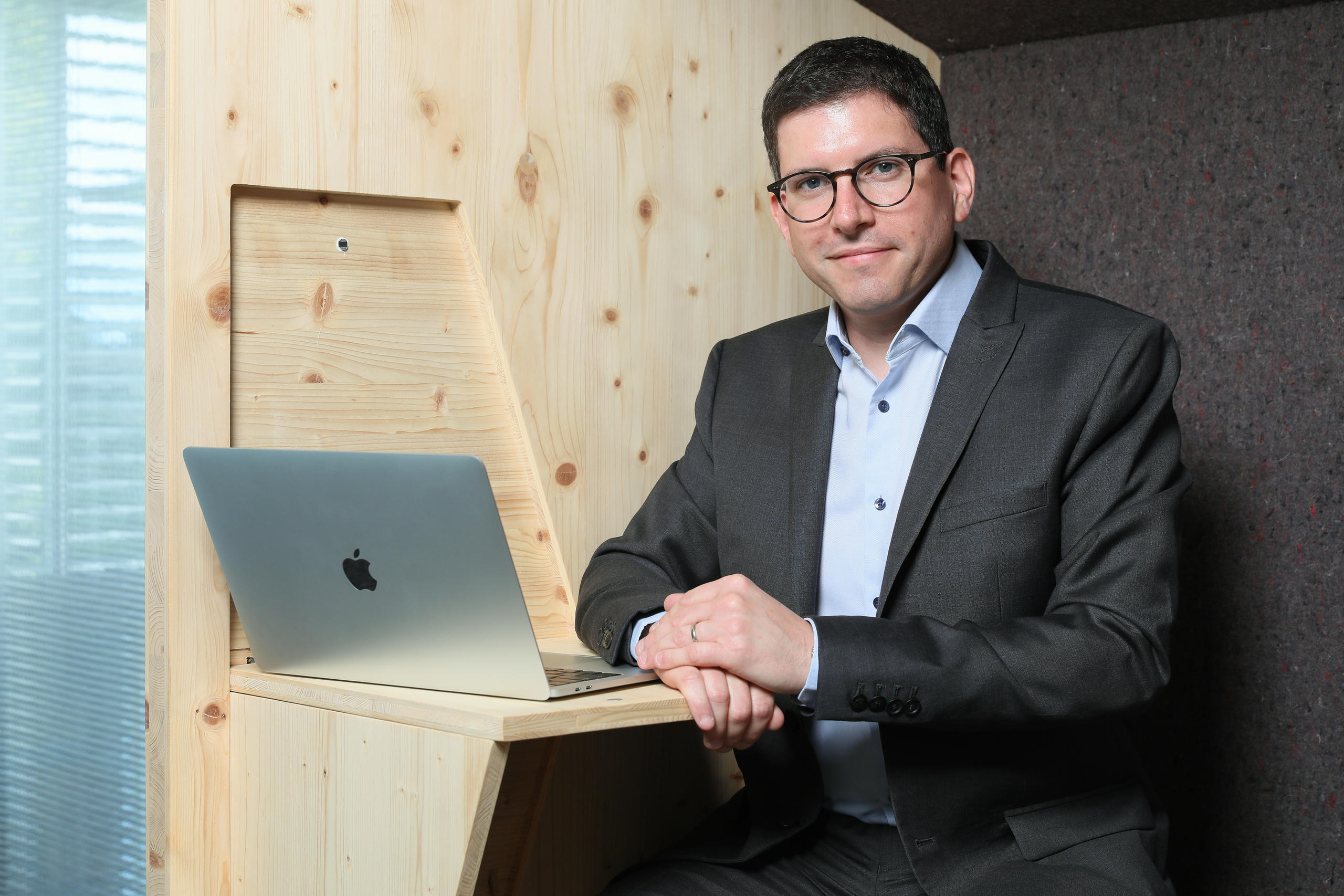Embattled news industry finds allies in ivory tower

From “fake news” to the loss of readers and advertisers, the list of challenges facing the media sector is long and daunting. Enter the new Initiative for Media Innovation, which wants to find novel ways to help outlets thrive in the digital age.
Mounir Krichane is working his way through the grim list of difficulties currently facing the news industry in Switzerland and other countries. As the director of the Media CentreExternal link at the Federal Institute of Technology Lausanne (EPFL), he has no magic solutions under his sleeve but a strong conviction about one approach in particular: partnerships.
“It’s become more difficult for media organisations big or small to tackle their challenges alone,” says Krichane. The digital shift in media has come so swiftly, he explains, that everyone is a step behind playing catch-up.
The aim of the Initiative for Media Innovation (IMI), which the engineer leads, is to connect researchers in their ivory tower or tech lab with news publishers interested in forward-thinking ideas for tackling the embattled industry’s biggest headaches.
“[We want to see] public-private partners getting together, in Switzerland and abroad, and looking at new, disruptive things that can help us to innovate in a big way,” he says.
Backed by the federal authorities, the initiative launched this summer with plans to fund projects through a sizable annual purse of CHF650,000 ($654,000). Partners include the Swiss Broadcasting Corporation, swissinfo.ch’s parent company, and a small number of top schools in the country, the EPFL among them (see infobox).

Making a profit online
Krichane is anything but coy about the hard work ahead. The first challenge on his list, he tells swissinfo.ch, is how news outlets can adapt their business model to compete in a hot digital market. Some 80% of Swiss get their news onlineExternal link, according to the latest poll done for the Reuters Institute. Readership of the print media, by contrast, has declined by eight percentage points in the last three years.
The question for many publishers, Krichane says, is “How do I make money if I am selling fewer papers?”
“In Switzerland, we have a lot of local papers and it’s not easy for them, as they don’t have a big audience, and going online is not easy, as it’s a market with a lot of players.”
As social networks morphed into major actors in the distribution of online news in recent years, mainstream outlets have had to adjust their content and distribution schemes just to be seen and heard on these platforms.
“For some media companies, the big players like Facebook are the one place where they can publish their content, so they’re losing control over how and what they publish [and] how they make money,” says Krichane.
To complicate matters, in early 2018 Facebook decided to prioritise posts from family and friends over publishers’ content in users’ newsfeed, a setback for those outlets that rely on social media to drive traffic to their sites.
In the face of such challenges, the largest publishers in Switzerland have deployed various strategies to safeguard profits, buying out smaller regional papers and centralising editorial production. Some have also experimented with other types of services, such as providing online marketplaces, as a way to further diversify their revenue sources.
Although this growing concentration of private media in the hands of a few, coupled with the disappearance of a number of print publications, has some critics worried, Krichane points to one positive reaction to this shift. Start-up publishers have emerged through crowdfunding efforts by readers in both the German and French-speaking regions who are keen to support quality, in-depth journalism. Their creation speaks to a broader trend of cultivating a pool of users and potential (paying) subscribers.

More
New publication aims to be ‘good for the head’
“In Switzerland and abroad, we are seeing media outlets thinking of new ways of engaging with their audience … by building a community, a local but strong audience,” he says. A critical aspect of the initiative’s work will be to understand how publishers can pull in more loyal users willing to dig into their pockets, a big concern for Swiss outlets that have seen paid subscriptions plummet.
Engage, but cautiously
But if publishers are keen to jump on the engagement bandwagon, Krichane cautions against getting it wrong. That’s another challenge on his list: how can publishers use data about their readers in an effective yet responsible manner?
“You can offer better services and connect more with the audience, but you have to do it in a way where you use only the information you need from the user,” he says. “You have to give people the choice, not force them to give out [personal] information.”
There is a fine line between harvesting data in order to personalise content and safeguarding the privacy of the user, and researchers involved in the IMI want to help publishers solve the ethical and social conundrums raised by the shift to digital.
Building loyalty is also about trust, and although trust in the Swiss media remains relatively high (at 52% in 2018, compared with an average of 44% across nearly 40 countries surveyed for the Reuters report), there is concern it is being threatened by loss of quality, bias and disinformation. The Reuters poll shows half of Swiss are worried about poor journalism and completely fabricated news.
Fight “fake news”
With the problem of misinformation high on the IMI’s list of priorities, Krichane says the first step would be for researchers to develop a “typology” of so-called “fake news” in Switzerland, to better understand “how they propagate on social platforms.” Although it’s difficult to know the extent to which ordinary users are exposed to false information, getting to grips with the scope of the problem could help regulators, and not just the media industry, come up with counter measures.
The initiative also wants to explore technological innovation in this area: “[We can] look at solutions, such as algorithms to measure veracity or transparency of news, or the degree of objectivity.”
Asked if people can have faith in technology as a solution if advances in tech are in large part to blame for the rapid spread and reach of disinformation online, Krichane says we don’t have a choice.
“There is no going back to [a time with] no technology,” he says, adding that although he agrees there is ongoing tension between large tech companies and traditional media over several issues, including disinformation, “there must be solutions for these actors to work together.”
In 2017 Facebook struck up partnerships with professional fact checkersExternal link to fight the spread of misinformation on its platform. Messaging service WhatsApp recently followed suitExternal link, saying it is working with fact checkers and awarding grants to researchers who can help the company get a grasp on its misinformation problem. And this year Facebook answered multiple calls for more data sharing by announcing a programmeExternal link to do just that with researchers looking into disinformation.
It remains to be seen if self-regulation by tech companies will have a lasting impact on the problem of “fake news”, Krichane admits, but he is confident that, just as platforms are trying to collaborate with the news industry, so too can the IMI build bridges between journalists and academics, first in Switzerland and eventually abroad. At his previous job in the digital lab of the French-language public broadcaster, RTS, Krichane met many media professionals ready to experiment with new formats.
“These are the key people [we need] to start building a bridge,” he says, “to have a community of journalists, students and researchers work on projects together. It’s part of the innovation ecosystem.”
More money for digital news
In a move that reflects the shift to digital media in news distribution and consumption, the Swiss government tabled draft legislation earlier this summer focused on supporting online media. The draft text, open for consultation until mid-October, is meant to replace the existing law on radio and television and calls, among other things, for the creation of an independent panel of experts to advise on electronic media. Financial support would also be available to training and educational institutions, including those geared at digital media.
The law, however, does not address misinformation, as the government has previously said it didn’t see the need for legislation on the issue and would continue instead to monitor developments.

More
How we used to consume ‘reel’ news

In compliance with the JTI standards
More: SWI swissinfo.ch certified by the Journalism Trust Initiative













You can find an overview of ongoing debates with our journalists here . Please join us!
If you want to start a conversation about a topic raised in this article or want to report factual errors, email us at english@swissinfo.ch.